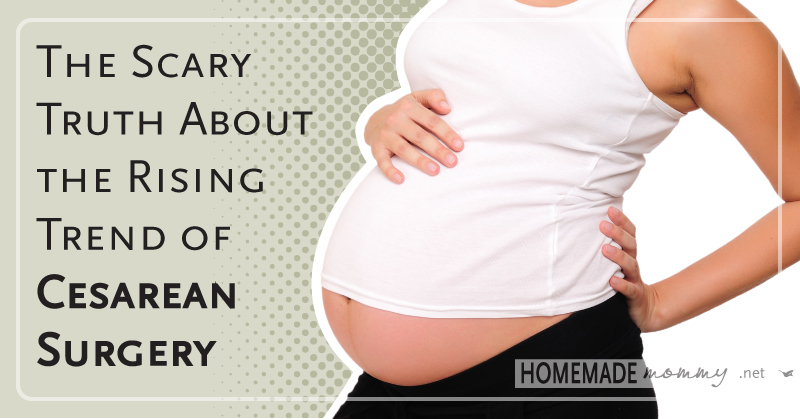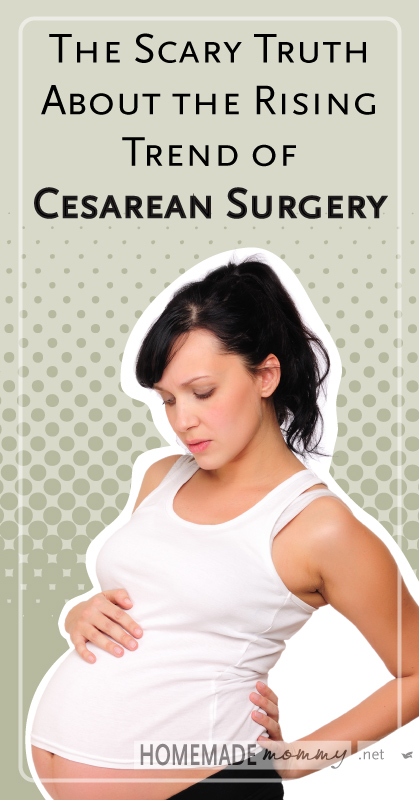
Cesarean section surgery, also know as C-sections, are becoming a lot more common place in the delivery room than they were even just a decade ago. Are complications to blame or is this medical intervention being used as an alternative to birthing naturally?
The Growing Trend of Cesarean Surgeries
The U.S. Department of Health and Human Services reports that Cesareans are on the rise by 53% since 1996. The C-section rate was listed as 21% in 1996 and a climbed to 32.8% in 2010. According to the World Health Organization the suggested rate of C-section should not exceed 15 percent. Cesareans can be beneficial in situations where complications arise. However, the problem is that these procedures are often used inappropriately on healthy women with little or no complications.
Dangers of Cesarean Surgeries
C-sections can result in problems in the mother such as:
- Infections
- Loss of blood
- Placenta problems
- Complications in future pregnancies
- Ongoing pelvic pain
- Uterine rupture and bowel blockage
Babies can experience:
- Breathing problems
- Difficulty breastfeeding
- Disruption in healthy gut flora
- Childhood onset diabetes and asthma
Why Are Cesarean Surgeries Skyrocketting?
With more and more information exposing how cesareans cause more harm than good, why are the numbers continuing to skyrocket with 1 in 3 women in the U.S. delivering by cesarean? Many people are under the misconception that the rise in C-section rates is due to complications in pregnancy and labor that make this surgery necessary. There are two major factors causing the increased trend.
1. Casual Attitude Towards Surgery
Our culture has become increasingly tolerant of clinical procedures, even when they are not medically necessary. Many common interventions such as Pitocin and Epidurals can cause side effects that prevent the mother from finding comfort. This causes the body to progress too slowly, which can result in fetal distress and increase the likelihood of a cesarean. Instead physicians should be informing more women on the complications and long-term problems that can occur, using interventions and procedures only when necessary.
2. Money Talks
It should come to no surprise that monetary and personal incentives also have a role in the sharp ascent in the surgical procedure. Payment schedules compensate more for a C-section as opposed to a vaginal birth. In addition to the higher monetary payout, the personal perks can be just as inviting. A C-section can be less time consuming and even better, a scheduled C-section can allow the practitioner to organize their work and personal life more efficiently without having to support a longer vaginal birth, while at the same time, earning more profit.
The Need For Change
Over the years there has become less and less of a medical focus on enhancing women’s confidence in the ability of the body during labor. Simply spending more time educating women on how to handle the birthing process, as well as fostering an environment to help make the mother as comfortable as possible, are healthier and less expensive alternatives to the operation. Healthy diet and exercise also play a key role in reducing the chances of having a cesarean. When women become empowered to take an active role in pregnancy and childbirth the need for unnecessary interventions is reduced.

















I believe another cause is the routine use of inducing labor. When the body is forced to try to go into labor earlier than it is ready for, oftentimes the labor does not progress and complications arise, and then cesaerian birth is called for. I don’t think many women are aware of this when they schedule an induction (which the practitioners are likely to recommend, again for their own scheduling!).
My mother went past 41 weeks with all 4 of her pregnancies. Now Drs. don’t want you to go past 41 weeks claiming its too dangerous. My first was induced and my body was just not ready, so I had a c-section. Again with my second, I wanted to vbac but my body wasn’t ready by 41 weeks so I had to schedule a c-section. Going in for surgery wasn’t exactly how I imagined bringing my baby into this world. I feel gipped and frustrated that I didn’t know to go with a midwife the first time around!
Hugs to you Janelle! All that matters in the end is that you and the babies were safe. I’m hoping my articles help to bring positive awareness towards childbirth and help empower women to explore all options to have an enjoyable birthing experience. Thank you for your comment!
I had a csection after going into labor naturally at 41 1/2 weeks with midwifery “care” with my first and an induced vbac with an awesome doctor with my second. I put “care” I’m quotation marks because THEY were the reason I had a csection
My point being….please don’t beat yourself up. Maybe it would have been the same outcome with a midwife…..
Also Janelle, I went to therapy for a while about a year and a half after my csection and it helped me come to terms with it a bit better. I’m still a little bitter….but much better:)
The reality is that your Dr. is afraid to get sued, so if your baby is messed up by a difficult delivery you are more likely to sue. The cost for OB/Gyn insurance is through the roof. My children were both 11 lbs. 2 weeks early. No chance of vaginal delivery. I chose an elective C-section the second time around. Quite frankly delivering him/or his older brother would have been like pushing a tire through a balloon. Saved me the cost of vaginal reconstruction.
I delivered a 10 lb. 8 oz. baby and didn’t even tear. This is not to say that you would have necessarily had the same outcome. The big baby threat is just used so often to scare women out of even attempting a vaginal delivery I wanted to share a positive “big baby” birth experience.
Thank you for sharing your experience Heather and thank you for your comment!
I think that this is missing a lot of facts, and most of it is speculation.
A huge percentage of the increase in c-sections is due to the fact that we have made huge strides in keeping premature births. In the 90s, a pregnancy that didn’t make it to at least 32 weeks wasn’t likely to end with a living baby going home with its parents. If you were losing the baby before that point, there was often very little the hospitals could do unless he mother’s life was I’m danger. Now, baby’s are being born and kept alive as early as 21 weeks. Between 1996 and 2004 (the early 2000s is when there was a huge increase in the ability to care for premature babies), the number of premature births of singletons increased by nearly 60,000, with 92% of them being born by c-section.
Another reason that c-sections are on the rise is fertility treatments. Because the CDC did not start tracking fertility treatments (and even then only ART treatments) until 2002, it’s hard to predict the impact all forms of fertility treatment have had on the rate of both prematurity and c-sections. However, the UK has similar recent birth rates from fertility treatments and their studies (limited only to IVF and ICSI) date back to 1991. In the UK, the numbers of infants born through IVF or ICSI more than quadrupled between 1992 and 2006, and the success rates of each cycle went from 17% to 29%. Additionally, fertility treatments have directly affected the instances of multiple births. The rate of twins rose 76% since 1980, though the rate of naturally conceived twins has been unchanged. And, while now on the decline thanks to newer regulations and options like selective reduction, births of triplets and higher quadrupled between 1980 and 1998. While some women give birth to twins naturally, it is more common for mothers to have one or both via c-section. And higher order multiples will almost always (if not always) receive a c-section.
Furthermore, between 1990 and 2005, the rate of induced labor doubled to an all time high of 22% of live births; and in 2010, the number was still about 20%. And, studies have shown that those with induced labor are twice as likely to receive c-section as those who went into labor naturally. And, another study found that as many as 44% of babies born before 41 weeks, without being breeched, had their labor induced.
Not to mention that, between 2004 and 2011 (policies changed in 2010), only 52% of women sought a VBAC if their first was a c-section, and of those 1/3 were unsuccessful and resulted in a second c-section. And, those who required a c-section as a result of induction were twice as likely to have a failed VBAC.
Finally, the World Health Organization officially withdrew its previous recommendation of 15% c-sections with an official statement reading, “There is no empirical evidence for an optimum percentage. What matters most is that all women who need Caesarean sections receive them.”
Even more frightening to me is that in my area, I have heard of MANY women electing to have C-sections because they were scared to go through a vaginal delivery! Why have surgery when your body is designed to do this on its own…
Thank you for your comment Rachel! I couldn’t agree more! Women need to trust more in our bodies and our babies that we have the ability to do this!
It’s been a while since I was researching this, but it seems to me that when I was the risk of DEATH for the mother was 6x higher for a cesarean delivery. Which would suggest that there are *not* “plenty more things that go wrong with traditional child birth,” as Lorn suggested.
The point here is that we need to be *educated*, and make decisions based on actual facts and not on what feels easiest, what the doctor finds most convenient, or what is more financially lucrative. Given a healthy mother and a healthy baby with no complications, the facts are that cesarean delivers carries more risk and less benefit. AND we know that unnecessary interventions have a tendency to screw things up, making cesareans necessary that otherwise wouldn’t have been.
These things play a role in the numbers. That’s just a fact. HOW MUCH of the numbers are attributable to these things is debatable; that they affect the numbers is really not.
I remember when we were expecting our first, our family physician trying to talk us into using the local hospital. (All of our children have been born at home.) At one point during the conversation, he told us that about 97% of births proceed naturally, as expected. (Those weren’t his exact words, but that was the gist. That there are no problems in 97% of deliveries.) Which, incidentally, exactly matched up with my own research. But then a few minutes later, he told us how “good” our local hospital’s cesarean rate was – “only” 25%.
That’s a pretty huge discrepancy. If 97% of deliveries are non-problematic, then even allowing for some wiggle room, where you thought you *might* need to intervene, but weren’t sure, that’s about 20% that are unnecessary. The numbers on both ends might be a little different now, but the discrepancy is still huge.
Those 20% are unnecessarily putting their babies and themselves (or their patients, if it’s the doctors pushing for it) at risk for complications and health problems.
It saddens me to see a post like this – one which, much like the arguments on the other side of the debate, focus on fear tactics rather than an even handed presentation of the data. I planned for 42 weeks to have a natural birth, and when we reached 42 weeks and my baby could not drop – you could actually feel his large head overriding my smaller than average pelvis, I had to have a C-Section or else my baby would have died in-utero and I’d have gone septic. Natural birth was not an option. But articles designed to push women towards one side or the other are also a huge part of why its taken me years to get over the guilt and feeling like less of a woman for having never been able to experience labor. Why not support your readers by presenting an even-handed, judgement-free approach to the information instead?